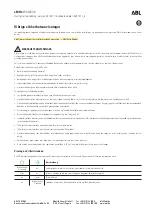
[
3
]
2 – Important Safety Instructions
Installation and Location Warnings
•
Install the battery cabinet in a controlled indoor environment, away from moisture, temperature extremes, flammable liquids
and gasses, conductive contaminants, dust and direct sunlight.
•
Install the battery cabinet in a level, structurally sound location.
•
The battery cabinet is extremely heavy; be extremely careful when moving or lifting the unit.
•
Operate the battery cabinet at indoor temperatures between 32° F and 104° F (0° C and 40° C) only. For best results, maintain
an indoor temperature of 77° F (25° C).
•
Leave adequate space around all sides of the battery cabinet for proper ventilation. Do not block, cover or insert objects into
the external ventilation openings of the battery cabinet.
•
Do not place any object on the battery cabinet, especially containers of liquid.
•
Do not attempt to stack the battery cabinet. Attempting to stack the battery cabinet may cause permanent damage and create a
potential for serious personal injury.
•
Do not attempt to unpack or move the battery cabinet without assistance. Use appropriate handling equipment rated to bear
the weight and bulk of the battery cabinet, such as freight elevators, pallet jacks and forklifts. (Fully extend forks under load.
Spread forks to maximum possible width under load. Lift cabinet from bottom only. Wear safety shoes.)
•
For emergency use, install a fire extinguisher rated for energized electrical equipment fires (Class C rating or exact
equivalent, with a non-conductive extinguishing agent) near the battery cabinet.
Connection Warnings
•
The battery cabinet contains hazardous high voltages that have the potential to cause personal injury or death from electric
shock.
•
The battery cabinet has its own energy source. The output terminals may be live even when the battery cabinet is not
connected to a UPS system.
•
The battery cabinet must be suitably grounded according to all applicable electrical wiring regulations.
•
Use of this equipment in life support applications where failure of this equipment can reasonably be expected to cause the
failure of the life support equipment or to significantly affect its safety or effectiveness is not recommended. Do not use this
equipment in the presence of a flammable anesthetic mixture with air, oxygen or nitrous oxide.
•
De-energize all input and output power sources before installing cables or making electrical connections.
•
Use flexible cable of sufficient length to permit battery cabinet servicing.
•
Use ferrule caps to cover termination cables and prevent frayed ends from shorting on terminal blocks. Use cabling rated
VW-1, FT-1 or better. Use cable sleeves and connector clamps.
•
Confirm that all cables are marked correctly according to their purpose, polarity and diameter.
•
Observe proper polarity by connecting negative to negative and positive to positive. Failure to observe proper polarity may
damage the batteries and create a serious risk of personal injury and property damage.
•
Wiring should be performed by trained, qualified electricians only.
•
If the battery cabinet does not include the shunt trip option, the final installation must include an easy-access disconnect
device between the battery and the load. The disconnect device must be suitably rated in accordance with applicable electrical
codes and the battery cabinet rating.
•
Do not connect the integrated battery charger (included with “C” models only) to the UPS system output. The
integrated battery charger requires a separate AC supply circuit.
SAVE THESE INSTRUCTIONS
All sections of this manual contain instructions and warnings that must be followed during the installation and operation of the
battery cabinet described in this manual. Read
ALL
instructions thoroughly before attempting to move, install or connect your
battery cabinet. Failure to comply may invalidate the warranty and cause serious property damage and/or personal injury.
DANGER! LETHAL HIGH VOLTAGE HAZARD!
All wiring should be performed by a qualified electrician, in accordance with the warnings in this manual
and all applicable electrical and safety codes. Incorrect wiring may cause serious personal injury and
property damage.


































